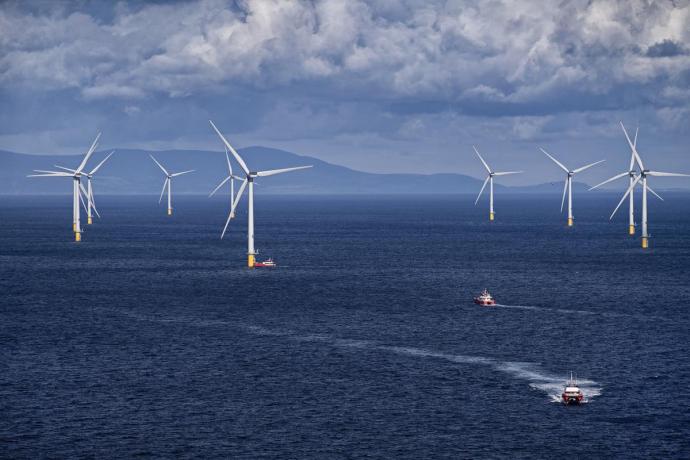
Now Reading
Clean and Stable, Offshore Wind Can More Than Meet the World’s Electricity Needs
More stable than solar or onshore wind, offshore wind could become a trillion-dollar business by 2040, and a mainstay of global power supply. Here are five key takeaways from the International Energy Agency’s recent offshore wind report.
Clean and Stable, Offshore Wind Can More Than Meet the World’s Electricity Needs
More stable than solar or onshore wind, offshore wind could become a trillion-dollar business by 2040, and a mainstay of global power supply. Here are five key takeaways from the International Energy Agency’s recent offshore wind report.
Published 11-11-19
Submitted by Ørsted
 Offshore wind could become a trillion-dollar business by 2040, helping meet global electricity needs. (Photo: Ørsted's Walney Extension offshore wind farm, UK)
Offshore wind could become a trillion-dollar business by 2040, helping meet global electricity needs. (Photo: Ørsted's Walney Extension offshore wind farm, UK)The sun doesn’t shine at night and the wind doesn’t blow continuously, which makes intermittency an obstacle to adding more solar and wind energy to the grid. But the IEA’s recent Offshore Wind Outlook 2019 says that offshore wind is not subject to the same intermittency limitations as onshore wind and solar PV.
The IEA classifies offshore wind as a “variable baseload technology” owing to its high capacity factors and lower variability, as compared with onshore wind and solar PV. Put simply, offshore wind operates, on average, at a higher share of its maximum power output and with less fluctuations. As such, offshore wind can provide more stable power to the energy grid, just as fossil-fuelled plants do, and “has the potential to become a mainstay of the world’s power supply.”
“The report shows that, through its bulk production of green and affordable energy, offshore wind will be a cornerstone in the global green transition, and provides value to the energy system comparable to dispatchable plants, such as those running on coal or gas,” says Ulrik Stridbæk, Vice President of Regulatory Affairs at renewable energy company Ørsted. “As a baseload technology, offshore wind will play an increasingly significant role in eliminating carbon emissions and tackling climate change.”
Here are five key takeaways from the report:
Electricity to power the world: Offshore wind accounts for 0.3% of global electricity production today. Even if only confined to windy regions, within 60km from the shore, and in water no deeper than 60m, the worldwide offshore wind potential is up to 36,000 terawatt hours of renewable electricity a year. That would outstrip current global electricity demand of 23,000 terawatt hours. Offshore wind power could become the largest source of electricity generation in Europe after 2040.
USD 1 trillion business by 2040: Offshore wind power capacity is set to expand, with the market adding 20GW* or more of offshore wind per year, by 2030. Around 40GW of capacity would need to be added each year in the 2030s to meet global climate goals.
Variable baseload technology: Offshore wind is a variable renewable energy source, but it generates power at high and stable rates. Modern wind turbines make the most of available wind resources and generate electricity during almost all hours of the day and tend to produce more electricity during the winter months and monsoon season.
Long term vision: Governments must set a long-term vision for offshore wind to ensure the necessary investments are made to allow the industry to grow. This will also help develop efficient supply chains in the industry, which are critical to delivering low-cost projects.
Onshore grid infrastructure: The success of offshore wind will depend on well-developed onshore grid infrastructure. That is essential for efficient integration of power production from offshore wind and to avoid offshore wind energy going unused.
Read the full report Offshore Wind Outlook 2019, which was funded by the governments of Denmark and Germany and developed in consultation with a selection of international experts including Ørsted.
*1GW of offshore wind is enough to power just over one million households in Europe, according to calculations made by Ørsted.
About Ørsted
The Ørsted vision is a world that runs entirely on green energy. Ørsted develops, constructs and operates offshore and onshore wind farms, bioenergy plants and provides energy products to its customers.
Carbon intensity of the company’s energy generation decreased by 83% in mid-2019, as compared with 2006 levels. By 2025, Ørsted will have reduced its emissions by 98% making the company’s energy production virtually carbon free.
83% of Ørsted’s energy generation was from renewable sources as of September 2019. The target is 99% in 2025.
The company is committed to reducing carbon emissions from end use of its products and in its supply chain by 50 percent by 2032, as compared to 2018.
Ørsted is ranked the world’s most sustainable energy company and fourth most sustainable company overall in the 2019 Global100 index.

Ørsted
Ørsted
The Ørsted vision is a world that runs entirely on green energy. Ørsted develops, constructs and operates offshore and onshore wind farms, solar farms, energy storage facilities, and bioenergy plants, and provides energy products to its customers. Ørsted ranks #1 in Corporate Knights' 2020 index of the Global 100 most sustainable corporations in the world and is recognised on the CDP Climate Change A List as a global leader on climate action. Headquartered in Denmark, Ørsted employs 6,600 people. Ørsted's shares are listed on Nasdaq Copenhagen (Orsted). In 2019, the group's revenue was DKK 67.8 billion (EUR 9.1 billion).
More from Ørsted
